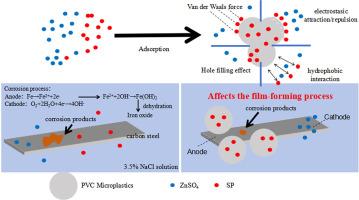聚氯乙烯微塑料对复合无机缓蚀剂性能及吸附行为的影响机理探讨
IF 6.3
2区 材料科学
Q2 CHEMISTRY, PHYSICAL
引用次数: 0
摘要
微塑料在溶液中的吸附问题已成为界面科学领域的一个重要研究热点。然而,目前还没有研究系统地探讨微塑料与无机缓蚀剂之间的相互作用。研究了聚氯乙烯(PVC)微塑料对由硫酸锌(ZnSO4)和聚磷酸钠(SP)组成的复合无机缓蚀剂体系缓蚀性能的影响。多种测试方法被用来阐明潜在的机制。实验结果表明,当复合缓蚀剂的添加浓度分别为100 mg/L和10 mg/L时,以腐蚀电流密度(icorr)计算,复合缓蚀剂的缓蚀效率为94.2%。PVC微塑料的引入显著改变了缓蚀剂的缓蚀效果。具体来说,随着微塑性含量的增加,复合抑制剂的性能先增强后下降。微塑料浓度为100 mg/L时,碳钢的icorr降低37%。多方面表征分析表明,微塑料对溶液中多磷酸离子的影响更为明显,表明它们对阳极反应过程的影响。微塑料可以作为多孔载体富集缓蚀剂,影响缓蚀剂的扩散和吸附过程,从而改变缓蚀剂在金属表面的吸附行为。相反,微塑料与碳钢的粘附影响了抑制膜的形成,从而改变了它们对渗透的阻隔性能。本研究全面分析了微塑料对无机缓蚀剂的影响机理,为缓蚀剂在富微塑料溶液中的应用提供了有价值的指导和见解。本文章由计算机程序翻译,如有差异,请以英文原文为准。

Discussion on the influence mechanism of PVC microplastics on the performance and adsorption behavior of composite inorganic corrosion inhibitors
The issue of microplastic adsorption in solution has emerged as a crucial research focus within the field of interfacial science. However, no studies have systematically explored the mutual interactions between microplastics and inorganic corrosion inhibitors. This study investigates the influence of polyvinyl chloride (PVC) microplastics on the corrosion inhibition performance of a combined inorganic inhibitor system comprising zinc sulfate (ZnSO4) and sodium polyphosphate (SP). Multiple testing methodologies were employed to elucidate the underlying mechanisms. Experimental results reveal that the addition of the composite inhibitors significantly inhibit the metal corrosion, achieving an inhibition efficiency of 94.2 % based on corrosion current density (icorr), when added at concentrations of 100 mg/L and 10 mg/L, respectively. The introduction of PVC microplastics markedly alters the inhibition effectiveness of the corrosion inhibitor. Specifically, as the microplastic content increases, the performance of the composite inhibitors initially enhances before declining. At a microplastic concentration of 100 mg/L, the icorr of carbon steel is reduced by 37 %. Multifaceted characterization analyses suggest that microplastics exert a more pronounced influence on polyphosphate ions in solution, indicating their effect on anodic reaction processes. Microplastics can enrich corrosion inhibitors as porous carriers, affecting their diffusion and adsorption processes, thereby altering their adsorption behavior on metal surfaces. Conversely, the adherence of microplastics to carbon steel influences the formation of inhibitive films, thereby altering their barrier properties against permeation. This study comprehensively analyzes the mechanisms underlying the influence of microplastics on inorganic corrosion inhibitors, offering valuable guidance and insights for the application of corrosion inhibitors in solution enriched with microplastics.
求助全文
通过发布文献求助,成功后即可免费获取论文全文。
去求助
来源期刊

Surfaces and Interfaces
Chemistry-General Chemistry
CiteScore
8.50
自引率
6.50%
发文量
753
审稿时长
35 days
期刊介绍:
The aim of the journal is to provide a respectful outlet for ''sound science'' papers in all research areas on surfaces and interfaces. We define sound science papers as papers that describe new and well-executed research, but that do not necessarily provide brand new insights or are merely a description of research results.
Surfaces and Interfaces publishes research papers in all fields of surface science which may not always find the right home on first submission to our Elsevier sister journals (Applied Surface, Surface and Coatings Technology, Thin Solid Films)
 求助内容:
求助内容: 应助结果提醒方式:
应助结果提醒方式:


